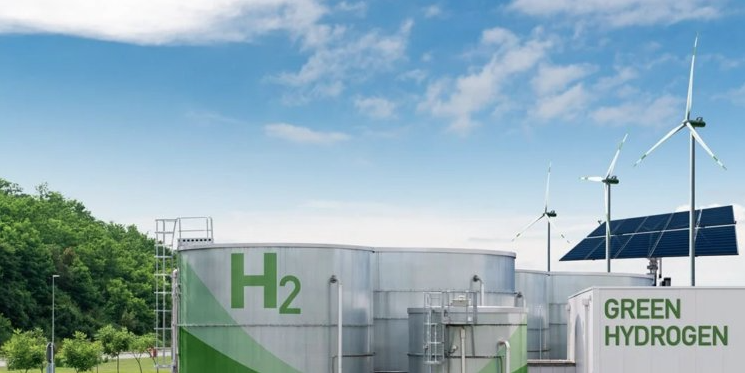Shock New Claim: ‘Green’ Hydrogen Produces 37 Times More Global Warming than Carbon Dioxide
Although the UK could do with a bit of warming!

by Chris Morrison from the The Daily Sceptic.
Dangerous stuff all this ‘green’ hydrogen. Apart from a tendency to explode unless handled with extreme care, its higher combustion temperature can produce more harmful nitrogen dioxide than natural gas. Nitrogen dioxide is a nasty pollutant and has been linked to childhood asthma and other major ailments. Furthermore, hydrogen is the lightest of gases and escapes easily into the atmosphere – where a newly-published science paper suggests, pound for pound, it produces 37 times the warming of carbon dioxide over a 20-year period. This is because hydrogen is oxidised by the hydroxyl radical leading to the formation of tropospheric ozone and stratospheric water vapour. Both these gases are so-called ‘greenhouse’ gases and alarmist scientists are keen to exaggerate their effect. If you are worried about atmospheric pollution and greenhouse gases, despite all past observational evidence that suggests the ‘greenhouse’ impact of the gases ‘saturates’ at certain levels, then promoting hydrogen is a very bad look indeed.
If green hydrogen was a poor person’s car, London Mayor Khan would have no hesitation in slapping a hefty Ulez charge on it. Obliging Imperial College might be relied on to provide a ‘statistical construct’ pointing out that hundreds of thousands of people will die.
But as is becoming increasingly clear, hydrogen is the only game still standing in town to back up unreliable wind and solar. Batteries are useless given their horrendous expense, limited lifespan and requirement to dig up vast quantities of the Earth’s crust. Not forgetting their tendency to explode and burn uncontrollably if not handled with care. Carbon capture appears to be an excellent opportunity for fools to be parted from their money chasing a ridiculous dream. One must fervently hope an efficient scheme to pull CO2 out of the atmosphere is never invented since removing 60% of the trace gas will lead to all plant and human life dying on Earth.
An interesting paper has just been published in the peer-reviewed journal Energy Science & Engineering which reviews the “challenges” with using the existing natural gas system to deliver hydrogen. It concludes that in considering hydrogen’s physical and chemical properties, “it is not an effective decarbonisation tool for use in homes and buildings”. Hydrogen is said to leak from pipes at a rate up to three or four times more than natural gas and, as suggested, the claimed effect on the atmosphere will not be easy for activists to excuse.
The paper is of interest since it seems to be the work of the Environmental Defence Fund, a highly influential Green Blob-funded activist and campaigning think tank. In short, it is another example of the penny dropping in even fanatical Net Zero circles about the lack of back-up energy for wind and solar. Not before time, it might be noted, since in countries like the U.K. there is still Miliband madness in the air with plans to ‘decarbonise’ the electricity grid by 2030.
Using hydrogen in existing gas systems has “major consequences for safety, energy supply, climate and costs”, argue the authors. Blending hydrogen with natural gas offers only small reductions in CO2 emissions, while a transition to full hydrogen is not possible without significant retrofits and replacements. The authors steer clear of putting a price on this but note that even if technical and “economic barriers” – the polite term for unimaginably large sums of money – are overcome, “serious safety and environmental risks remain”.
Concern is also expressed about the manufacturing process to produce hydrogen. There are noted to be more than 1,000 proposed projects aimed at scaling up zero and low-carbon hydrogen, but there are said to be “challenges” associated with each “clean” production method. “No method is universally beneficial to the climate,” they note.
Last year, an influential report from the U.K. Royal Society kicked batteries into touch as a viable electricity storage solution for unreliable wind and solar. But lacking any alternative back-up, the Royal Society turned to hydrogen as a possible solution. The report envisaged dissolving huge salt caverns capable of decadal storing of ‘green’ hydrogen. Salt caverns, which anyway would leak hydrogen through permeable loss, are only available in a few places in the U.K., so a huge network of specialist pipelines would be needed to move the gas to turbines on constant standby. Specialist pipelines that would cost billions of pounds and would invariably leak and present a danger to anyone in the vicinity. At the time, Francis Menton of the Manhattan Contrarian noted that the authors’ “quasi-religious commitment” to a fossil-free future led them to minimise and divert attention away from critical cost and feasibility issues.
Bottom line – there is no cost effective, feasible, reliable and scalable replacement for hydrocarbons available, or likely to be available, in the near future. Blackouts and severe rationing will be inevitable if uncompromising ideologues like Ed Miliband at the U.K. Department of Energy continue to be allowed to wreak havoc with the energy requirements of a modern industrial society.
Chris Morrison is the Daily Sceptic’s Environment Editor.
The Beginners Guide To The Climate Con Out Now!







